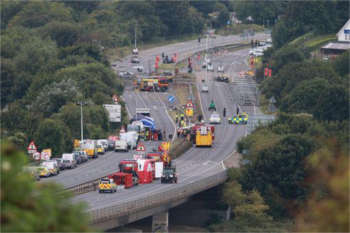On the first anniversary of the tragic Shoreham Airshow crash today (22 August), British Air Display Association (BADA) chair John Turner has told Transport Network that overall numbers of shows have fallen during the 2016 season.
Reasons include higher insurance premiums, tougher Civil Aviation Authority (CAA) requirements, and local authorities directing tight event budgets elsewhere.

Recovery work in the aftermath of the Shoreham crash
The sector's recovery has not been helped by a March 2016 row between BADA and the CAA over, among other issues, increases in the latter's regulation fees.
At Shoreham, a vintage Hawker Hunter fighter jet involved in a failed manoeuvre killed 11 people when it plunged into traffic on the busy A27 near the airfield in Sussex.
An initial report by the Department for Transport's Air Accidents Investigation Branch (AAIB) found that the organisers did not fully risk-assess the planned sequence of manoeuvres.
The AAIB is due to produce its final report this autumn. It has already highlighted research, published in the CAA's 2014 'Flightcrew Human Factors Handbook', showing that pilots are 'considerably more likely' to crash during a show, indicating the likelihood of increased stress and anxiety shifting their role towards that of an 'airshow pilot persona'.
The CAA is now developing an accreditation scheme for flying display directors that will require them to demonstrate knowledge of key human factors issues.
Meanwhile aviation specialists at lawyers Irwin Mitchell, who are representing a number of injured victims and relatives of the dead, have told Transport Network that their clients – none of whom were willing to speak to the media - still want to understand exactly why the incident occurred.
'Some of those affected may never fully recover', a spokesperson said.